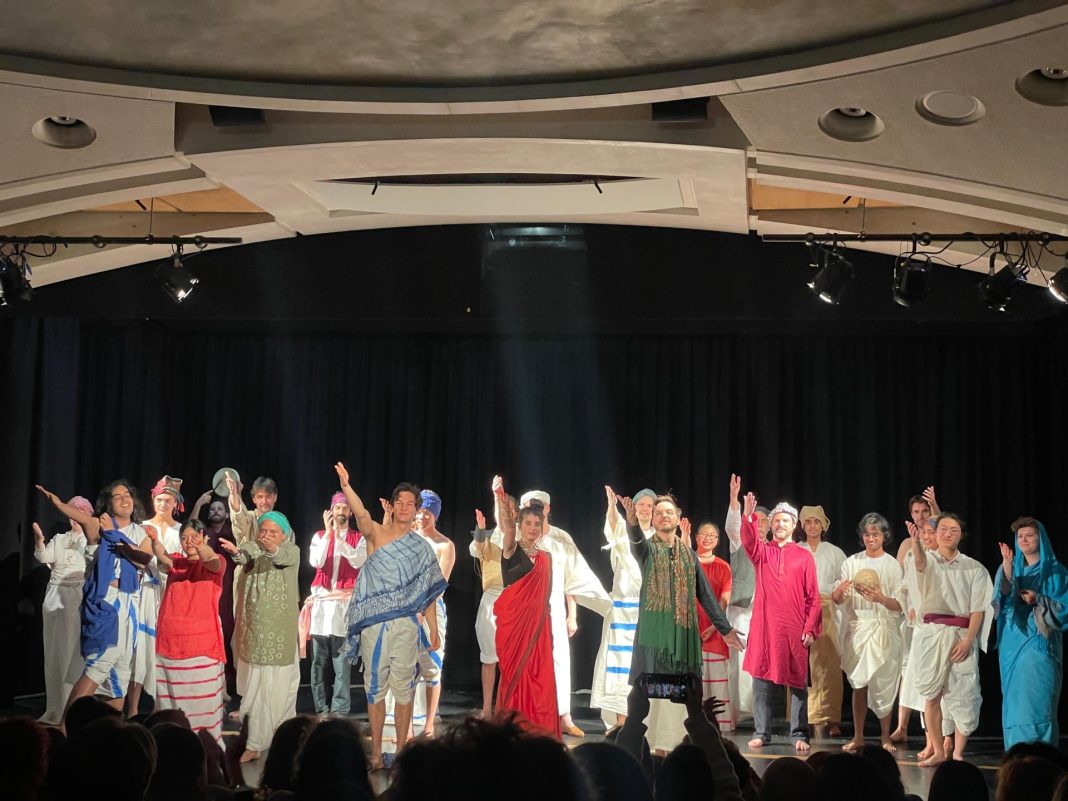As students left Oxford on the last weekend of Hilary, I visited St John’s College’s auditorium to witness the final hurrah of term: the biennial Sanskrit play. This year, the play of choice was Śūdraka’s Mṛcchakatika (The Little Clay Cart), directed by Ricardo Paccagnella and delivered entirely in Sanskrit, with surtitles translated by Professor Toby Hudson and Dominik Tůma. Both the Saturday and Sunday night performances were almost entirely sold-out, making the event a joyful reinvigoration of Sanskrit literature and legacy, bringing together long-time learners of Sanskrit and the completely uninitiated alike.
The play follows the folk tale, formalised in verse by Śūdraka, of the generous and impoverished brahmin Cārudattaḥ (Lucas Ali-Hassan), as he falls in love with the highly-respected, wealthy courtesan Vasantasenā (Althea Sovani). However, their romance is threatened by the king’s arrogant brother-in-law, Saṃsthānakaḥ (Riccardo Paccagnella), who pursues Vasantasenā despite her refusal of him, believing that if he can’t have her, no one should.
Given that the original play would have been performed for at least six hours, Paccagnella and his crew did an impressive job of cutting down the runtime to just over two. Yet, what impressed me even more was that the actors were able to deliver all their lines over the course of 150 minutes with little falter, including the song-like classical rasas (‘poetic sentiments’, as explained by the brochure). The first strain of this metre, put to melody, was slightly jarring to hear – the only contemporary theatre we really see songs in is musicals, after all, and this play was far from that – but it didn’t take too long to attune. The cast wove deftly in and out of these refrains, with the script also interspersed with surprisingly comic moments. Particularly commendable in this respect were Paccagnella’s and Althea’s performances: their deliveries were effusive and evocative, clearly expressing the snide plotting of Saṃsthānakaḥ and the joyful wit of Vasantasenā. Not only did they bring their characters to life, but it was clear to me – despite my complete lack of Sanskrit knowledge – what part of the line they were delivering: A feat of acting, not just academics.
This play and its characters were also surprising in just how familiar they were. Despite being written one and a half millennia ago, many of the elements of The Little Clay Cart are still highly recognisable to a modern audience: the scheming villain with unguarded ambition; the down-on-his-luck hero, noble to a fault; the plucky, irreverent best friend – known here as Maitreyaḥ (Vishal Rameshbabu). Its themes of jealousy, adoration, slighted masculinity, poverty, corruption – all these are timeless and endlessly explored. Even the comedy of errors that drives the main action of the plot seems to foreshadow Shakespeare by almost a thousand years; equally, the moments of pathos and genuine shock from the audience as Saṃsthānakaḥ seems to succeed in his goal, demonstrates its lasting resonance.
Throughout the play, the ingenuity required of all student productions also came through in many ways. While on stage, the costumes were flawlessly executed – striped dhoti, transparent veils, and loose, looping fabrics, in the style of paintings found in the Ajanta caves, providing a distinctive look for each character – the behind-the-scenes of the costuming revealed a flurry of activity. The brochure for the play showed reams of fabric laid out in college JCRs and gardens, waiting for the stripes of paint to dry; as housemates with one of the costumers, Benjamin Atkinson, I was a first-hand witness to the time he spent on this project; from whittling spears for the guards to tie-dying fabric. The eponymous carts rattling familiarly across the stage were themselves the trundling trolleys used for transporting Merton College’s vacation storage. Knowing the secrets behind the aesthetics of the play didn’t ruin it by any means – in fact, it only made it all the more spectacular to see it come together.
More than that, the play was also a bringing together of people. On entry, I noted that the audience was predominantly made up of relatively older attendees – townspeople, without direct affiliation to the University, who might have already come to see previous Sanskrit productions before. Various professors also made up the ensemble, alongside students: Seeing Professors Diwakar Acharya and Jonathan Katz play as the villainous Saṃsthānakaḥ’s lackeys was comic to say the least. In many ways, this untraditional ensemble reflects the ways in which the original 5th century script broke with convention: it featured various dialects spoken by common people, collectively known as Prakrits, and not just the Sanskrit of the elite; it told the stories of courtesans, thieves, and gamblers, not just the nobility; and it did not borrow from mythology, but from the lives of real people.
It’s clear that a lot of heart went into The Little Clay Cart – the love that the entire ensemble had for the language shone through the whole production. It’s definitely worth keeping your eye out for the next time that one of these Sanskrit plays, just like a little clay cart, rolls around.


